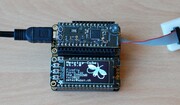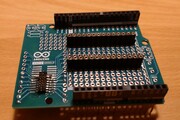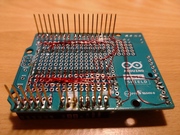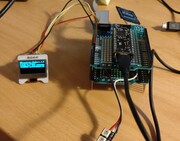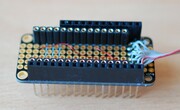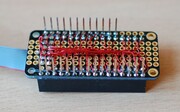Mecrisp-Cube for the Firefly BLE Development Board
Intro
Unfortunately the STM32WB Feather Development Board is no longer available.
But there is a very good substitute the Firefly designed by Tlera Corp.
The pinout is very similar to Arduino UNO but with the size of an Arduino Nano (or a Teensy). The GPIOs are very carefully selected. JTAG SWD is on the pin header too!
Instant real-time programming with Forth.
Sources on GitHub
designed by Tlera Corp.
The pinout is very similar to Arduino UNO but with the size of an Arduino Nano (or a Teensy). The GPIOs are very carefully selected. JTAG SWD is on the pin header too!
Instant real-time programming with Forth.
Sources on GitHub (Firefly branch on Mecrisp-Cube)
(Firefly branch on Mecrisp-Cube)
Features
The standard Mecrisp-Cube features like RTOS, Filesystem, USB, etc.- 63 KiB RAM Forth dictionary
- 128 KiB Flash Forth dictionary
- 50 KiB for C code
- Internal Flash drive 0:, 384 KiB (for details see Nucleo)
- microSD drive 1: (needs external adapter)
- Digital and analog pins
- LED1 (blue), PE4
- Button, PH3
- Digital port pins: D0 to D15
- Analog port pins: A0 to A4
- PWM: TIM1CH3 D0, TIM1CH2 D1, TIM1CH1 A4
- Input capture TIM2CH2 A1
- Output compare TIM2CH1 D13, TIM2CH3 A2, TIM2CH4 A3
- EXTI: D2, D4, D7, D10
- UART: D0 RX, D1 TX
- SPI: D13 SCK, D12 MISO, D11 MOSI (e.g. for display, memory)
- I2C: D14 SDA, D15 SCL (external peripherals e.g. pressure sensor)
- Optional Neopixel on port D8
Getting Started
These instructions will get you a copy of the project up and running on your local machine (STM32WB Firefly Developer Board) for development and testing purposes.Prerequisites
- Firefly BLE Development Board
 with STM32WB55 MCU (Cortex ARM M4) runs at a 32 MHz (the Bluetooth stack runs on a Cortex ARM M0+ core). If you want to debug C and assembler programs you need an ST-Link debugger/programmer e.g. STLINK-V3MINIE
with STM32WB55 MCU (Cortex ARM M4) runs at a 32 MHz (the Bluetooth stack runs on a Cortex ARM M0+ core). If you want to debug C and assembler programs you need an ST-Link debugger/programmer e.g. STLINK-V3MINIE .
.
- Terminal emulator application for PC, e.g.:
MecrispCubeFirefly.bin) or the FS-binaryMecrispCubeFireflyFS.bin, everything included e.g. internal flash drive and Forth utilities) to the Firefly Board.
- Connect the Firefly Board USB to the PC
- Hold the BTN button (BOOTP Pin), push the nRST button, release the nRST button
- Program the binary (
MecrispCubeFirefly.binorMecrispCubeFireflyFS.bin) with the STMCubeProgrammer (select USB Device) - Reset or power cycle the Firefly board
/dev/ttyACM0).
I set the putty terminal configuration to
- Implicit CR in every LF
- Local echo: Auto
- Local line editing: Auto
- Keyboard Backspace: Control-H
- Keyboard Function: Keys VT100
- Remote character set: CP850
Mecrisp-Stellaris RA 2.5.4 by Matthias Koch. Mecrisp-Cube 1.5.0 for STM32WB Firefly, 63/128 KiB RAM/FLASH dictionary (C) 2022 peter@spyr.ch * Firmware Package STM32Cube FW_WB V1.14.1, USB-CDC, BLE Stack 5.3 (C) 2022 STMicroelectronics * CMSIS-RTOS V2 FreeRTOS wrapper, FreeRTOS Kernel V10.3.1 (C) 2020 Amazon.com * FatFs for internal flash and microSD - Generic FAT fs module R0.12c (C) 2017 ChaN * tiny vi - part of BusyBox (C) 2000, 2001 Sterling Huxley include 0:/etc/rc.local 23 5 / .[CR] 4 ok. : hello ." World" ;[CR] ok. hello[CR] World ok.
Special Functions on Startup
USB-CDC is the default console.- Button BTN
- start STM bootloader
- blue LED
- the LED lights up during the initialization phase
Neopixel as Status Indicator
The optional NeoPixel displays the status- dimmed Green
- USB enumeration successfull
- dimmed Blue
- BLE connected
- flashing Red
- "disk" (serial flash or SD) write operation
- flashing Yellow
- "disk" (serial flash or SD) read operation
Additional Tools and Local Filesystem
There are two drives available, drive 0: is the flash drive (384 KiB internal flash, see MicroSdBlocks#Flash_Drive) and drive 1: is the microSD drive (optional MicroSdBlocks#SD_Drive). Populate a microSD with the contents of sdcardls -l 1:[CR] drw- 0 2021-04-18T18:12:38 boot drw- 0 2021-03-21T18:47:52 etc drw- 0 2021-03-21T18:47:54 fsr drw- 0 2021-03-21T18:47:54 home drw- 0 2021-03-21T18:47:56 man -rwa 7219 2021-01-08T19:42:36 README.md ok.You can use the local CLI commands like
mkfs, mkdir and cp to create a filesystem on the serial flash and fill it with files and folders. But this is tedious job because I haven't yet implemented a recursive copy for MecrispCube. But there is prepared disk image
(for details see MicroSdBlocks#Serial_Flash) on microSD and the tool dd. You can copy the disk image to the drive 0: (this takes about 2 Minutes):
dd 1:/boot/fd-384k.img 0:[CR] ok. mount 0:[CR] ok. ls 0:[CR] man fsr README.md boot etc home ok.The Mecrisp have some tools bundled in its distribution e.g. assembler, disassembler, dump, float. I put those tools and some more into the folder
/fsr. With the "init.fs script" I compile my favorite ones into the flash directory (if you use the FS-binarycompiletoflash[CR] ok. include /etc/init.fs[CR] init.fs Loading started RAM Dictionary: 392991 KiB utils.fs loading ... conditional.fs loading ... dump.fs loading ... disassembler-m3.fs loading ... float.fs loading ... threads.fs loading ... RAM Dictionary: 392981 KiB init.fs finished ok.For example, the word disassember is available now:
see dump[CR]
080405F0: B500 push { lr }
080405F2: F7C2 bl 08002A3E --> cr
080405F4: FA24
080405F6: CF08 ldmia r7 { r3 }
080405F8: F013 ands r2 r3 #F
080405FA: 020F
080405FC: F847 str r3 [ r7 #-4 ]!
080405FE: 3D04
08040600: 2A00 cmp r2 #0
08040602: D000 beq 08040606
08040604: 3610 adds r6 #10
08040606: CF08 ldmia r7 { r3 }
08040608: F847 str r6 [ r7 #-4 ]!
Installing Development Environment
A step by step series of examples that tell you how to get a development env running Install the IDE STM32CubeIDEpsi@homer:~> git clone --branch firefly https://github.com/spyren/Mecrisp-Cube Klone nach 'Mecrisp-Cube' ... remote: Enumerating objects: 1157, done. remote: Counting objects: 100% (1157/1157), done. remote: Compressing objects: 100% (620/620), done. remote: Total 3183 (delta 720), reused 934 (delta 525), pack-reused 2026 Empfange Objekte: 100% (3183/3183), 41.60 MiB | 6.96 MiB/s, Fertig. Löse Unterschiede auf: 100% (2100/2100), Fertig.Import the project into the IDE:
File -> Import -> General -> Existing Projects into Workspace -> Select root directory Copy project into workspace Browse to Mecrisp-Cube directoryGenerate code from the STM32CubeMX
MecrispCubeFirefly.ioc file:
Project -> Generate CodeRestore changed source files
$ git status
{list of changed files}
$ git restore {files to restore}
or simpler
$ git stash $ git dropSelect the Build Configuration (Debug if you want to debug the project) and Build the project:
Project -> Build Configurations -> Set Active -> Debug/Release Project -> Build Project
Extensions
Arduino UNO Adaptor
It is a one evening project to solder this adaptor. For the pinout see BoardSupportPackageFirefly#Pinout and the JTAG see BoardSupportPackageFirefly#JTAG_SWD.- Arduino Proto Shield

- 0.1" pin sockets, e.g. Female Headers
 , Preci-dip
, Preci-dip
- 10 or 14 pin 0.05" JTAG/SWD header e.g. Samtec 14 pin FTSH-107-01-L-DV-K-A

- Magnet Wire, 30 AWG, Enameled Copper
| DIL# | Descr | Descr' | UNO | UNO' | Pin |
|---|---|---|---|---|---|
| 1 | GND | GND | |||
| 2 | D0 | UART_RX | RX | GPIO0 | CN4.1 |
| 3 | D1 | UART_TX | TX | GPIO1 | CN4.2 |
| 4 | D2 | GPIO2 | CN4.3 | ||
| 5 | D3 | GPIO3 | CN4.4 | ||
| 6 | D4 | GPIO4 | CN4.5 | ||
| 7 | D5 | GPIO5 | CN4.6 | ||
| 8 | D6 | GPIO6 | CN4.7 | ||
| 9 | D7 | GPIO7 | CN4.8 | ||
| 10 | D8 | GPIO8 | CN1.1 | ||
| 11 | D9 | GPIO9 | CN1.2 | ||
| 12 | D10 | GPIO10 | CN1.3 | ||
| 13 | D11 | SPI_MOSI | GPIO11 | MOSI | CN1.4 |
| 14 | D12 | SPI_MISO | GPIO12 | MISO | CN1.5 |
| 15 | D13 | SPI_CLK | GPIO13 | SCK | CN1.6 |
| 16 | D14 | SCL | SCL | GPIO15 | CN1.10 |
| 17 | D15 | SDA | SDA | GPIO14 | CN1.9 |
| 18 | A0 | D16 | A0 | GPIO16 | CN3.1 |
| 19 | A1 | D17 | A1 | GPIO17 | CN3.2 |
| 20 | A2 | D18 | A2 | GPIO18 | CN3.3 |
| 21 | A3 | D19 | A3 | GPIO19 | CN3.4 |
| 22 | A4 | D20 | A4 | GPIO20 | CN3.5 |
| 23 | SWCLK | ||||
| 24 | SWDIO | ||||
| 25 | nRST | RESET | CN2.3 | ||
| 26 | 3.3V | 3.3V | CN2.4 | ||
| 27 | GND | GND | CN2.6 | ||
| 28 | VIN | VIN | CN2.8 |
Adafruit Feather Adaptor
https://learn.adafruit.com/adafruit-feather/feather-specification- Stacking headers

- FeatherWing Proto

- 0.1" sockets, 2 x 14 e.g. Female Headers
 , Preci-dip
, Preci-dip
- Magnet Wire, 30 AWG, Enameled Copper
- optional for debugging .050 Low Profile Tiger Eye IDC Ribbon Cable

| DIL# | Descr | Descr' | Feather | Feather' | Pin | SWD ST |
|---|---|---|---|---|---|---|
| 1 | GND | GND | JP1.13 | 5, 7, 11 | ||
| 2 | D0 | UART_RX | RX | GPIO0 | JP1.3 | 13 |
| 3 | D1 | UART_TX | TX | GPIO1 | JP1.2 | 14 |
| 4 | D2 | GPIO11 | JP3.6 | |||
| 5 | D3 | GPIO12 | JP3.5 | |||
| 6 | D4 | GPIO13 | red LED | JP3.4 | ||
| 7 | D5 | GPIO5 | BUTTONC | JP3.10 | ||
| 8 | D6 | GPIO6 | BUTTONB | JP3.9 | ||
| 9 | D7 | A5 | JP1.7 | |||
| 10 | D8 | Neopixel | ||||
| 11 | D9 | GPIO9 | BUTTONA | JP3.8 | ||
| 12 | D10 | GPIO10 | JP3.7 | |||
| 13 | D11 | SPI_MOSI | MOSI | GPIO25 | JP1.5 | |
| 14 | D12 | SPI_MISO | MISO | GPIO24 | JP1.4 | |
| 15 | D13 | SPI_CLK | SCK | GPIO23 | JP1.6 | |
| 16 | D14 | SCL | SCL | GPIO15 | JP3.11 | |
| 17 | D15 | SDA | SDA | GPIO14 | JP3.12 | |
| 18 | A0 | D16 | A0 | GPIO16 | JP1.12 | |
| 19 | A1 | D17 | A1 | GPIO17 | JP1.11 | |
| 20 | A2 | D18 | A2 | GPIO18 | JP1.10 | |
| 21 | A3 | D19 | A3 | GPIO19 | JP1.9 | |
| 22 | A4 | D20 | A4 | GPIO20 | JP1.8 | |
| 23 | SWDCLK | 6 | ||||
| 24 | SWDIO | 4 | ||||
| 25 | nRST | RESET | JP1.16 | 12 | ||
| 26 | 3.3V | 3.3V | JP1.15 | 3 | ||
| 27 | GND | GND | JP1.13 | |||
| 28 | VIN | USB | JP3.3 |
2 or 16 MiB QSPI NOR Flash
The only thing I really miss is a serial Flash (like the one the Katydid has). But it is not a big deal to add one.
This work by Peter Schmid is licensed under a Creative Commons Attribution-ShareAlike 4.0 International License.
| I | Attachment | History | Action | Size | Date | Who | Comment |
|---|---|---|---|---|---|---|---|
| |
firefly-adaptor-back.jpg | r1 | manage | 383.7 K | 2022-11-23 - 11:19 | PeterSchmid | |
| |
firefly-arduino-adaptor-bottom.jpg | r1 | manage | 4532.6 K | 2022-10-17 - 19:28 | PeterSchmid | |
| |
firefly-arduino-adaptor-top.jpg | r1 | manage | 992.3 K | 2022-10-17 - 19:28 | PeterSchmid | |
| |
firefly-feather-adaptor-top.jpg | r1 | manage | 282.4 K | 2022-11-23 - 11:19 | PeterSchmid | |
| |
firefly-feather.jpg | r1 | manage | 433.8 K | 2022-11-23 - 11:37 | PeterSchmid | |
| |
firefly-header.jpg | r1 | manage | 63.5 K | 2022-10-17 - 19:34 | PeterSchmid | |
| |
firefly2.jpg | r1 | manage | 662.4 K | 2022-08-29 - 19:43 | PeterSchmid | |
| |
firefly4-c.jpg | r1 | manage | 1664.2 K | 2022-10-17 - 19:28 | PeterSchmid | |
| |
header.jpg | r1 | manage | 51.7 K | 2022-08-29 - 19:52 | PeterSchmid | |
| |
wbfeather.jpg | r1 | manage | 697.5 K | 2021-07-01 - 20:38 | PeterSchmid |
Topic revision: r28 - 2022-12-03 - PeterSchmid
Ideas, requests, problems regarding TWiki? Send feedback

